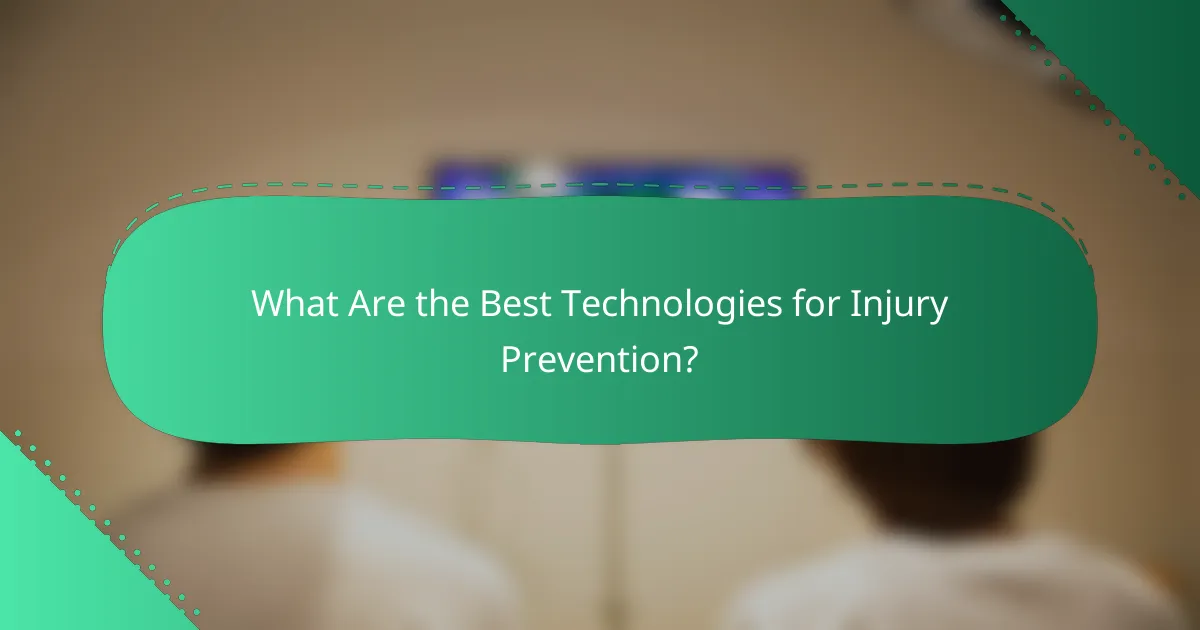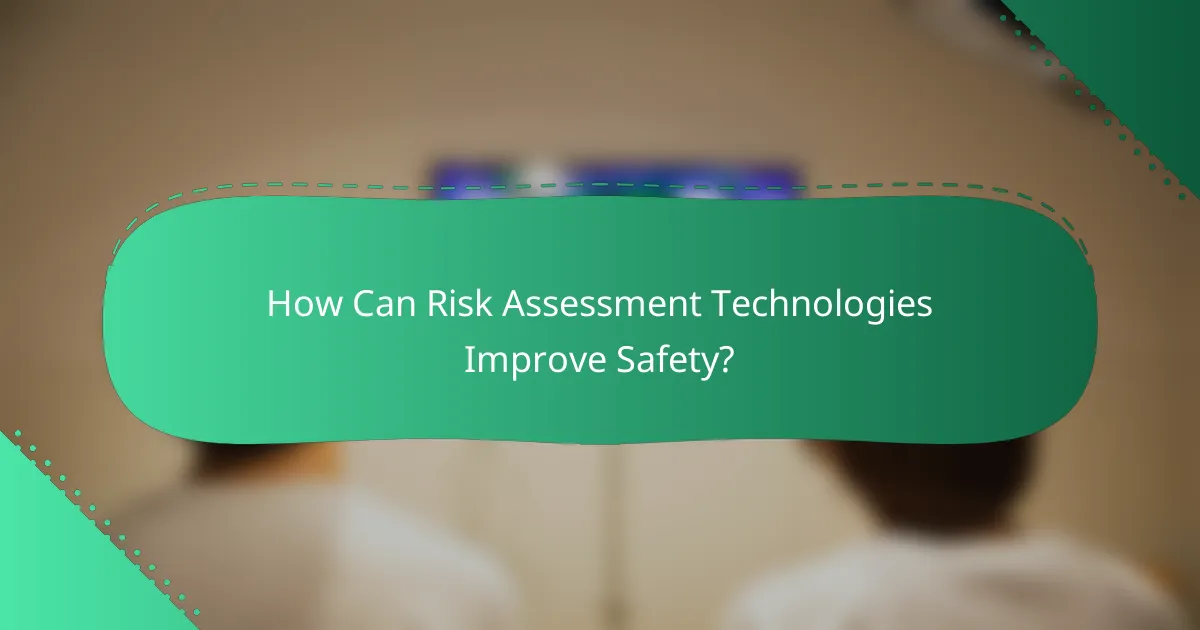Advancements in technology are revolutionizing injury prevention, risk assessment, and recovery support. Wearable devices and AI-driven software enhance safety by monitoring health metrics and predicting potential injuries, while risk assessment tools systematically identify hazards to create safer environments. Additionally, recovery support technologies offer personalized rehabilitation plans and facilitate communication between patients and healthcare providers, ensuring effective recovery processes.

What Are the Best Technologies for Injury Prevention?
The best technologies for injury prevention include wearable devices, smart helmets, biomechanical analysis tools, AI-driven injury prediction software, and virtual reality training systems. These innovations help monitor health metrics, enhance safety, and provide insights to reduce the risk of injuries in various environments.
Wearable devices
Wearable devices, such as fitness trackers and smartwatches, monitor vital signs and physical activity levels in real-time. They can alert users to potential health issues, such as abnormal heart rates or fatigue, which may lead to injuries. Popular options include devices from brands like Fitbit and Garmin, which often feature heart rate monitoring and GPS tracking.
When choosing a wearable device, consider battery life, comfort, and compatibility with other health apps. Look for features like fall detection and emergency alerts, which can enhance safety during physical activities.
Smart helmets
Smart helmets integrate technology to enhance safety, particularly in high-risk environments like construction sites or sports. These helmets often include sensors that detect impacts, monitor environmental conditions, and provide communication capabilities. For instance, some models can alert users to dangerous conditions or provide real-time data to supervisors.
When selecting a smart helmet, ensure it meets relevant safety standards, such as those set by the American National Standards Institute (ANSI) or the Occupational Safety and Health Administration (OSHA). Evaluate features like weight, comfort, and battery life to ensure usability during extended wear.
Biomechanical analysis tools
Biomechanical analysis tools assess movement patterns to identify risk factors for injuries. These tools often use motion capture technology and force plates to analyze how individuals move during activities. This analysis can help in tailoring training programs to improve performance and reduce injury risk.
Consider using these tools in conjunction with professional guidance from physiotherapists or sports scientists. They can provide insights into specific weaknesses and recommend targeted exercises to enhance strength and flexibility.
AI-driven injury prediction software
AI-driven injury prediction software analyzes data from various sources, such as training loads and historical injury records, to predict potential injuries. By identifying patterns and risk factors, these tools can help coaches and athletes make informed decisions about training intensity and recovery strategies.
When implementing such software, ensure it is user-friendly and integrates well with existing training systems. Regularly update the data inputs to maintain accuracy in predictions and adjust training plans accordingly.
Virtual reality training systems
Virtual reality (VR) training systems create immersive environments for practicing skills and scenarios without the risk of real-world injuries. These systems are particularly useful in sports training and rehabilitation, allowing users to simulate high-pressure situations safely.
When selecting a VR training system, consider the range of scenarios it offers and its adaptability to different skill levels. Ensure that the system is designed to provide feedback on performance, helping users refine their techniques and reduce injury risk over time.

How Can Risk Assessment Technologies Improve Safety?
Risk assessment technologies enhance safety by systematically identifying potential hazards and evaluating their impact. These tools enable organizations to proactively manage risks, leading to safer environments and reduced incidents.
Data analytics platforms
Data analytics platforms analyze large sets of data to identify trends and patterns related to safety incidents. By leveraging historical data, organizations can pinpoint high-risk areas and implement targeted interventions. For instance, a manufacturing facility might use analytics to discover that certain machinery has a higher incident rate, prompting preventive maintenance or operator training.
When selecting a data analytics platform, consider factors such as integration capabilities with existing systems, ease of use, and the ability to generate actionable insights. Popular platforms often include features like dashboards and real-time reporting, which can significantly enhance decision-making processes.
Risk management software
Risk management software helps organizations systematically identify, assess, and mitigate risks. This software typically includes modules for risk assessment, incident tracking, and compliance management, allowing for a comprehensive approach to safety. For example, a construction company might use this software to manage safety protocols and ensure compliance with local regulations.
When implementing risk management software, ensure it aligns with your organization’s specific needs. Look for customizable features that allow you to adapt the software to various scenarios, such as different project types or regulatory requirements.
Predictive modeling tools
Predictive modeling tools use statistical techniques to forecast potential safety incidents based on historical data. These tools can help organizations anticipate risks before they occur, allowing for timely interventions. For instance, a logistics company might use predictive analytics to determine the likelihood of accidents during peak delivery times.
To effectively utilize predictive modeling tools, organizations should focus on data quality and relevance. Regularly updating the data inputs and refining the models based on new information will improve accuracy and reliability in predictions.
Incident reporting applications
Incident reporting applications streamline the process of documenting and analyzing safety incidents. These applications allow employees to report incidents in real-time, which can lead to quicker responses and better data collection. For example, a hospital might implement an app that enables staff to report near misses or accidents immediately, fostering a culture of safety.
When choosing an incident reporting application, prioritize user-friendliness and accessibility. Ensure that the application is mobile-compatible and provides clear guidelines for reporting, which can encourage more employees to participate in safety initiatives.

What Are Effective Recovery Support Technologies?
Effective recovery support technologies enhance rehabilitation by providing remote access to care, personalized plans, and real-time monitoring. These tools facilitate communication between patients and healthcare providers, ensuring a tailored recovery experience.
Telehealth platforms
Telehealth platforms enable patients to consult healthcare professionals remotely, which is particularly beneficial for those with mobility issues or living in rural areas. These platforms often include video conferencing, messaging, and electronic health record access, allowing for continuous support and monitoring.
When choosing a telehealth service, consider factors such as user-friendliness, security features, and whether it is covered by your insurance. Popular platforms include Doxy.me and Teladoc, which offer various services tailored to different medical needs.
Rehabilitation apps
Rehabilitation apps assist patients in following their recovery protocols through guided exercises and progress tracking. Many of these applications provide instructional videos, reminders for exercises, and the ability to log symptoms or pain levels.
Look for apps that offer customization based on your specific injury or condition. Examples include MyRehab and Physitrack, which allow users to receive tailored exercise plans from their therapists and track their adherence over time.
Wearable recovery monitors
Wearable recovery monitors track vital signs and physical activity, providing real-time data that can inform recovery strategies. Devices like smartwatches or fitness trackers can measure heart rate, sleep quality, and activity levels, helping users understand their recovery progress.
When selecting a wearable, consider battery life, compatibility with other devices, and the accuracy of the metrics provided. Popular options include Fitbit and Apple Watch, which offer various health monitoring features suitable for recovery support.
AI-driven personalized recovery plans
AI-driven personalized recovery plans use algorithms to analyze patient data and create tailored rehabilitation programs. These systems can adapt based on user feedback and progress, ensuring that the recovery plan remains effective and relevant.
When exploring AI solutions, look for platforms that integrate with your existing health data and offer user-friendly interfaces. Services like Kaia Health and Hinge Health utilize AI to provide personalized exercises and feedback, enhancing the recovery experience.

What Criteria Should You Consider When Choosing Technologies?
When selecting technologies for injury prevention, risk assessment, and recovery support, consider usability, integration, cost, and scalability. These criteria ensure that the technology effectively meets your needs and can adapt to future demands.
Usability and user experience
Usability is crucial for ensuring that users can effectively interact with the technology. A user-friendly interface minimizes training time and enhances engagement, which is vital in high-stress environments like healthcare or sports. Look for systems that offer intuitive navigation and clear instructions.
Consider conducting user testing with potential end-users to gather feedback on the technology’s interface. This can help identify any pain points and ensure that the system aligns with the users’ workflows.
Integration with existing systems
Integration capabilities are essential for seamless data flow between new technologies and existing systems. Technologies that can easily connect with current software reduce duplication of efforts and enhance data accuracy. Assess whether the technology supports common standards like HL7 or FHIR for healthcare applications.
Evaluate the potential need for custom APIs or middleware to facilitate integration. This can add to the initial setup cost and complexity, so weigh these factors against the benefits of improved interoperability.
Cost-effectiveness
Cost-effectiveness involves not only the initial purchase price but also ongoing operational costs. Look for technologies that provide a clear return on investment through improved efficiency or reduced injury rates. Consider both direct costs, such as licensing fees, and indirect costs, like maintenance and training.
Compare different solutions by calculating the total cost of ownership over a defined period, typically three to five years. This approach helps identify which options deliver the best value for your budget.
Scalability and flexibility
Scalability ensures that the technology can grow with your organization. Choose systems that can accommodate an increasing number of users or expanded functionalities without significant additional costs. This is particularly important in dynamic environments where needs may change rapidly.
Flexibility is also key; look for technologies that can be customized or configured to meet specific requirements. This adaptability can be a significant advantage as your organization evolves or as new regulations emerge.

How Do Technologies Impact Workplace Injury Prevention?
Technologies play a crucial role in enhancing workplace injury prevention by providing tools for risk assessment, monitoring, and recovery support. These innovations help identify hazards, streamline safety protocols, and facilitate employee well-being.
Risk Assessment Technologies
Risk assessment technologies utilize data analytics and machine learning to identify potential hazards in the workplace. These systems analyze historical injury data, environmental factors, and employee feedback to pinpoint areas of concern.
Implementing risk assessment tools can lead to proactive measures, such as redesigning workspaces or modifying tasks to reduce injury likelihood. For example, wearable devices can monitor workers’ movements and alert them to unsafe practices in real-time.
Injury Prevention Solutions
Injury prevention solutions include ergonomic tools, safety training apps, and automated safety systems. Ergonomic assessments can be enhanced through software that evaluates workstation setups and suggests adjustments to minimize strain.
Safety training apps provide interactive learning experiences, ensuring employees are well-informed about best practices. Automated systems, such as machine guards and alert systems, can prevent accidents by stopping machinery when unsafe conditions are detected.
Recovery Support Technologies
Recovery support technologies focus on aiding employees during their rehabilitation process. Telehealth services allow injured workers to consult healthcare professionals remotely, facilitating quicker access to care.
Additionally, apps that track recovery progress can motivate employees by providing feedback and reminders for rehabilitation exercises. This support can significantly reduce recovery time and improve overall workplace morale.

